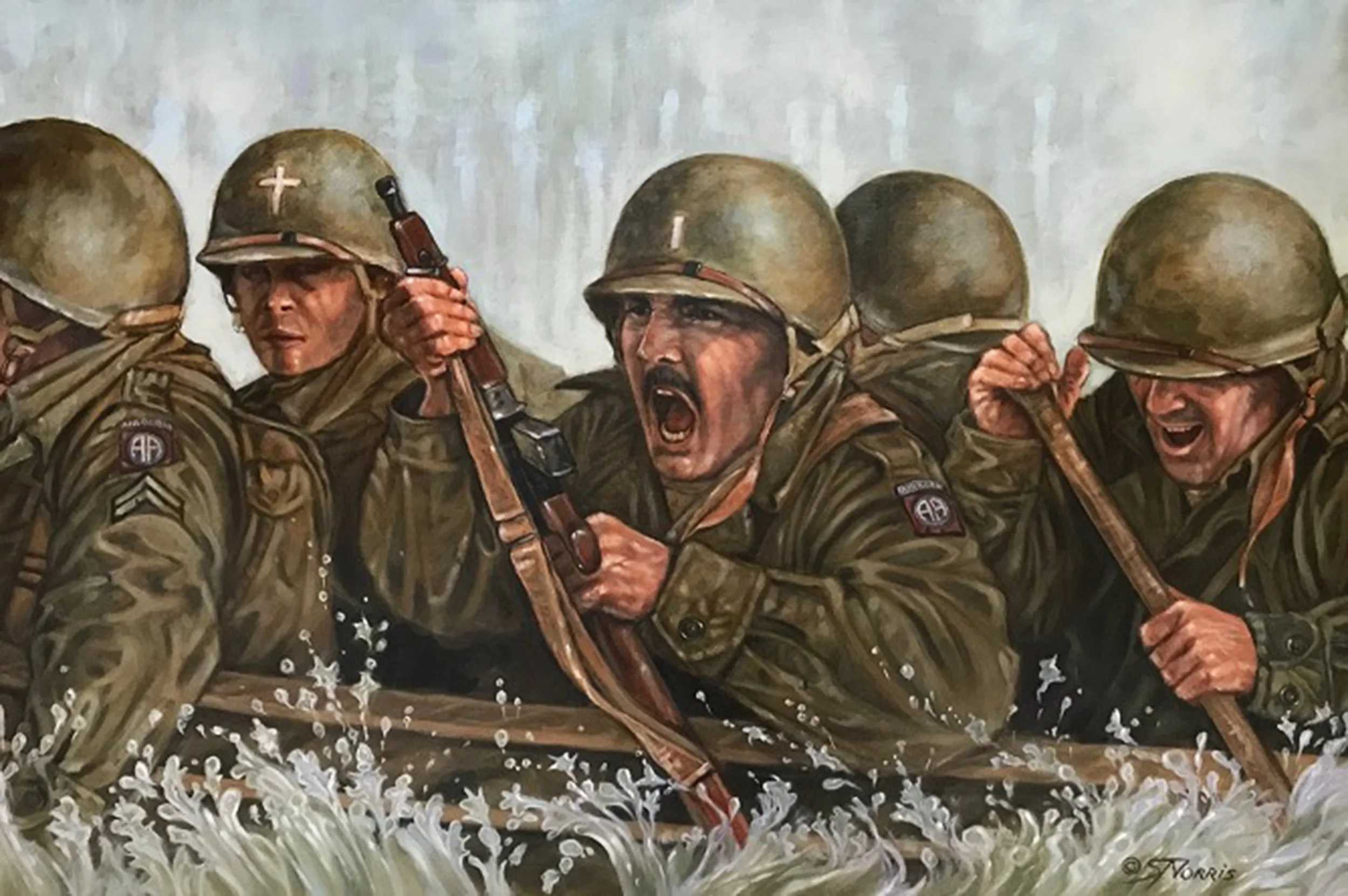“MY MISSION IS NOT YET COMPLETE”
An Untold Story of World War II Hero “Maggie” Megellas
Artwork & Story by Susan Norris
'THE PAINTING'
Lt. James “Maggie" Megellas, 27, with his men furiously paddling across the Netherlands’ Waal River in 1944 in a hail of enemy bullets in the famous assault against Nazi occupation.
(Painting by Susan Norris)
I’ve been fortunate to create sculptures and paintings that are in galleries and public and private collections, but nothing prepared me for a commission to do a painting for a man’s 103rd birthday.
I had never heard of James Megellas, nicknamed “Maggie.”
James “Maggie” Megellas, who died at 103, was one of the most decorated Army veterans of World War II with the Distinguished Service Cross, two Silver Stars, two Bronze Stars, two Purple Hearts, and the first American to receive an award for bravery from the Netherlands. (Courtesy photo)
I would soon learn that he was one of the most decorated army veterans of World War II, with the Distinguished Service Cross, two Silver Stars, two Bronze Stars and two Purple Hearts. He narrowly missed being awarded the Medal of Honor. He later served two tours in Vietnam and retired as a lieutenant colonel.
The painting would be of it. Maggie, then 27, in 1944 leading his men in a flimsy boat across 400 yards of river water in the Netherlands in a hail of German bullets. The boat didn’t have enough paddles, so in desperation, the men used their rifle butts and even their hands to push their boat safely to shore. Only 11 of the 26 boats launched made it.
A paratrooper, Maggie had parachuted some 60 miles behind enemy lines in a massive airdrop, but six troop carrier planes were shot down while bullets ripped through Maggie’s plane, killing two, as he and others exited the door.
Maggie would be the first American to receive an Award for Bravery by the Netherlands.
The allied offensive against the Germans in the Netherlands, called market garden, would be immortalized in the 1977 star-laden epic film, a bridge too far. Actor John Ratzenberger, who starred as the mailman in the comedy series Cheers (1982-1993), portrayed Maggie.
I first met Maggie in his comfortable Texas home. Wearing a plaid shirt, he rose to shake my hand as befits a gentleman. I soon learned that he loved to talk, had an encyclopedic memory, and was confident for 102 years old. I was a willing listener.
He told me about his crossing the Waal River at Nijmegen to liberate the Netherlands from Nazi occupation. He had told the story many times before, for newspapers and magazines, his autobiography, and a PBS movie titled Maggie’s War: A True Story of Courage, Leadership, and Valor in World War II. He told me of several battles, of carrying a wounded soldier on his back while firing a machine gun and dropping grenades into a Nazi tank.
I was in awe, but not awe-struck. I was talking with someone who sacrificed a lot for his country. This was a famous but very old, humble man who sat before me.
He asked me to name the painting “my mission is not yet complete,” because he hated wars, found them sometimes necessary, but fervently wished people could be more kind to each other. He would say, “the greatest generation has not yet been born. They will be the generation that does not send its young people off to die in wars but rather learns to live in peace. The Lord did not put us on this earth to kill each other.”
Later, to help my painting be accurate, I was invited to see reenactors in Texas re-create the famous crossing of the Waal River. I got realistic action photos. I was concerned about the period uniforms being too clean and neat, as Maggie and his company hadn’t changed clothes for days. But I could fix that in the painting.
Maggie’s 103rd birthday arrived. It was no small celebration. Sold out in advance, it was held in a Dallas luxury hotel by the Tribute to Valor Foundation which engages students with the values of the Medal of Honor: courage, sacrifice, patriotism, citizenship, integrity, and commitment. The foundation awards scholarships to students in science and math.
A separate room was filled with impressive period-correct displays of equipment from Maggie’s old unit, the 82nd Airborne, along with reenactors dressed in World War II airborne uniforms. Maggie was escorted by an elite group including Medal of Honor recipients and John Ratzenberger. Also, there was foundation director and singer, songwriter, producer, and actor Tony Orlando, whose 1973 song “Tie a Yellow Ribbon Round the Ole Oak Tree” topped the charts and became the standard for hope that a loved one would return home.
After the elegant meal in the decorated ballroom, I was invited to present my painting. I was so emotionally charged that I can’t remember exactly what I said, but, it was something about being honored to be there. Maggie sat at his table, and the covered painting was placed near him.
As the painting was unveiled, I looked into Maggie’s eyes as he gazed at the painting. They filled with tears, and he buried his face in his hands.
Maggie died three weeks later. When I think of Maggie, I also think of my family. My father was from England, my mother, Germany. Like Maggie, I am a first generation American.
My mother’s father was a Lutheran minister in Germany. He spoke out against Germany’s war- making when he taught a confirmation class and was turned in by one of his students. When my mother was 12, my grandfather was sent to the Dachau concentration camp, where he died with at least 32,000 others, probably many more.
Maggie told me that as the war ended, he helped liberate a concentration camp at Wobbelin, where dead were piled high in buildings among the sick and dying. He once said, “when we talked to the survivors, we realized the greater cause we were fighting for.”
On his 103rd birthday, at the celebration, Maggie was reunited with a man he helped liberate from that camp 75 years before. The man brought his children, grandchildren and great- grandchildren. I was overwhelmed thinking all of them might not have been born without Maggie’s help.
I am thankful I am here, too, because of Maggie and tens of thousands like him who fought and sacrificed so others could live free. Others are thankful, too.
The Dutch built a magnificent new bridge across the Waal River and gratefully named it Oversteek, which translates in English as “the crossing.” It is the largest war monument in Europe. At sunset, 48 paired bridge lights, for the 48 American soldiers who died in 1944 in the river crossing for the freedom of the Netherlands, light up pair by pair at a slow marching pace.
Every night, regardless of weather, a military veteran of the day walks the sunset march, across the bridge, walking in pace with the lights. The veteran wears a beret, military insignia, personal medals, and salutes a monument engraved with the names of the 48 soldiers.
Maggie, followed by a crowd of old and young, crossed the river again 73 years later, at 100 years old, as veteran of the day at a sunset march.
Each year on the anniversary of the river assault that Maggie survived, the citizens of Nijmegen take part at sunset in a massive, moving observance to honor the 48 American soldiers killed at the crossing.
To find out more about James 'Maggie' Megellas, scan the QR Code.
The author, Susan Norris (susannorrisartworks.com), lives and works in cimarron, New Mexico. To contact Susan for more information or an interview, call her at (575) 770-5725 or email her at: susannorrisartworks@gmail.com



